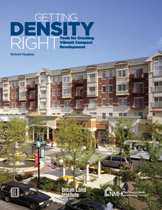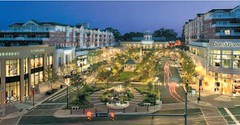Getting density right

Posted June 19, 2008 at 1:00PM
The Urban Land Institute and National Multi-Housing Council, in association with the Sierra Club, have produced a terrific new book and toolkit for citizens, businesses, and advocates called Getting Density Right.
 As the description on the web site of the ULI says, “Based on expert forums of practitioners from the public and private sectors, this book describes tools used throughout the nation to better support compact development, including visioning, planning, and new regulations. Case studies profile the experiences of eight communities, the policy tools they used to encourage compact development, and the development projects built using the new regulations. In addition, The Toolkit provides an overview of the tools being used across the country to promote compact development.
As the description on the web site of the ULI says, “Based on expert forums of practitioners from the public and private sectors, this book describes tools used throughout the nation to better support compact development, including visioning, planning, and new regulations. Case studies profile the experiences of eight communities, the policy tools they used to encourage compact development, and the development projects built using the new regulations. In addition, The Toolkit provides an overview of the tools being used across the country to promote compact development.
“This book comes with a DVD set produced by NMHC (The National Multi Housing Council) that contains visually engaging PowerPoint presentations created by a unique collaboration between environmentalists and real estate organizations to show how density can transform communities. Perfect to present at meetings of planning officials, civic groups, neighborhood groups, and chambers of commerce.” The book describes a variety of policy instruments useful to smart-growth planners and advocates, including the following:
- Form-Based Codes
- Model Codes
- Renovation Building Codes
- Mixed-Use Zoning Districts
- Planned Unit Development
- Overlay Zones
- Development Types
- Brownfields Redevelopment
- Cluster Development and Conservation Design
- Infill Development
- Traditional Neighborhood Development
- Transit-Oriented Development
- Density and Design Tools
- Accessory Housing and Cottage Housing
- Design Review and Guidelines
- Development Rating Systems
- Financial Incentives
- Transportation Demand Management
- Street Classification and Design
- Planning and Visioning
- Community Visioning Workshops and Charrettes
- Density Visualization Techniques
- Transect-Based Planning
 The slide presentations are terrific, and the kit includes a content-rich and annotated, but highly accessible 38-page booklet called Higher-Density Development-MYTH AND FACT that uses illustrations, case studies, and references to alleviate fears that some citizens have about higher density with eight salient points:
The slide presentations are terrific, and the kit includes a content-rich and annotated, but highly accessible 38-page booklet called Higher-Density Development-MYTH AND FACT that uses illustrations, case studies, and references to alleviate fears that some citizens have about higher density with eight salient points:
- The nature of who lives in higher-density housing—fewer families with children—puts less demand on schools and other public services than low-density housing. Moreover, the compact nature of higher-density development requires less extensive infrastructure to support it.
- No discernible difference exists in the appreciation rate of properties located near higher-density development and those that are not. Some research even shows that higher-density development can increase property values.
- Higher-density development generates less traffic than low-density development per unit; it makes walking and public transit more feasible and creates opportunities for shared parking.
- The crime rates at higher-density developments are not significantly different from those at lower-density developments.
- Low-density development increases air and water pollution and destroys natural areas by paving and urbanizing greater swaths of land.
- Attractive, well-designed, and well-maintained higher-density development attracts good residents and tenants and fits into existing communities.
- Our population is changing and becoming increasingly diverse. Many of these households now prefer higher-density housing, even in suburban locations.
- People of all income groups choose higher-density housing.
 While I suspect that few of these points constitute news to regular readers of this blog, it is very handy to have them spelled out in ready-to-use presentations and handbooks. One of the DVDs is even narrated, so it is well-suited to presentations hosted by newcomers to these issues.
While I suspect that few of these points constitute news to regular readers of this blog, it is very handy to have them spelled out in ready-to-use presentations and handbooks. One of the DVDs is even narrated, so it is well-suited to presentations hosted by newcomers to these issues.
"Unlike many toolkits, which simply conduct literature reviews and compile the results, Getting Density Right is based on nearly a year's worth of field research," explained NMHC president Doug Bibby. "We held a series of forums across the country where we did the unthinkable: We brought together in one room developers, elected officials, neighborhood activists and zoning officials to identify the obstacles, and in some cases their objections, to compact development. Then we brainstormed 'best practices' that will create compact communities that will meet everyone's needs."
Getting Density Right may be ordered here.